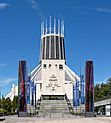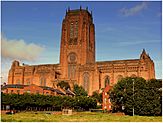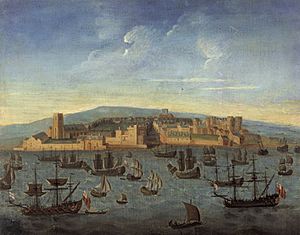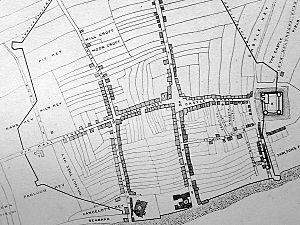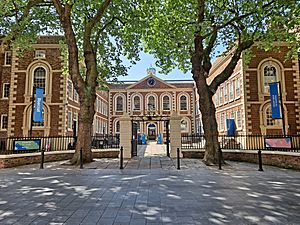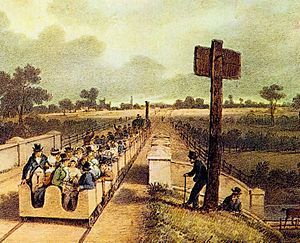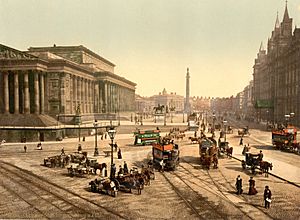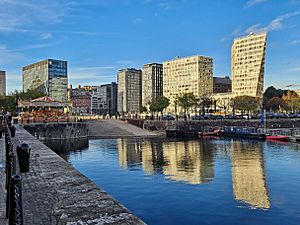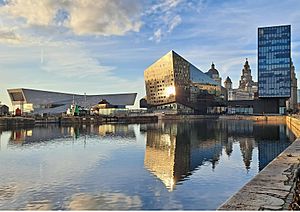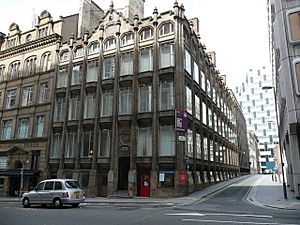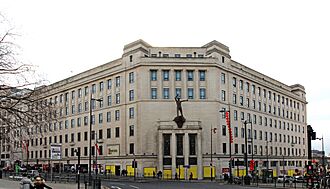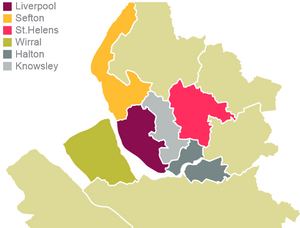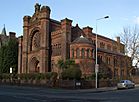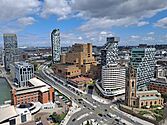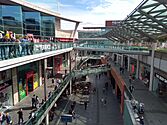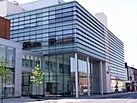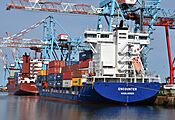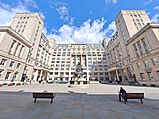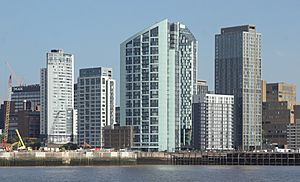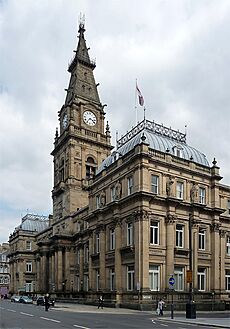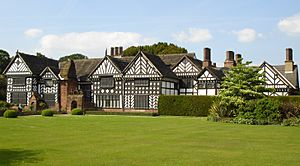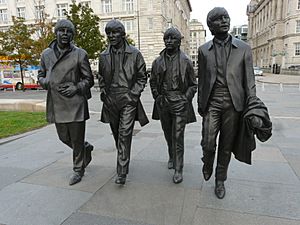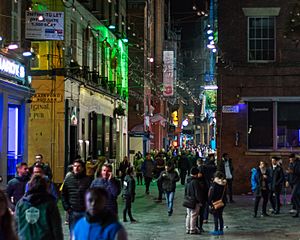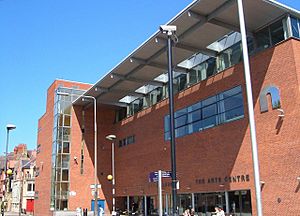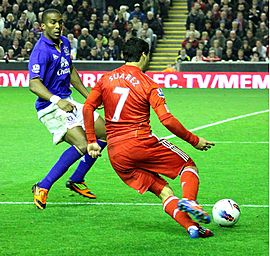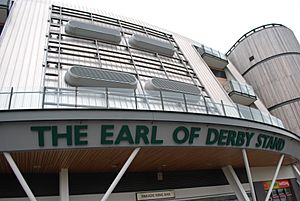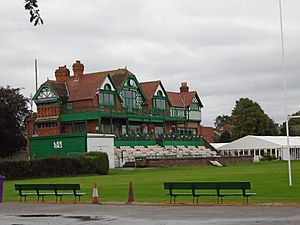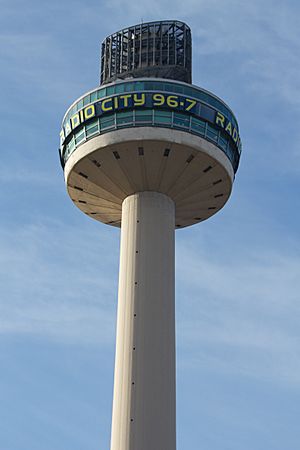Liverpool facts for kids
Quick facts for kids
Liverpool
|
|||
|---|---|---|---|
|
Liverpool waterfront seen from the River Mersey
Three Graces
|
|||
|
|||
| Motto(s): | |||
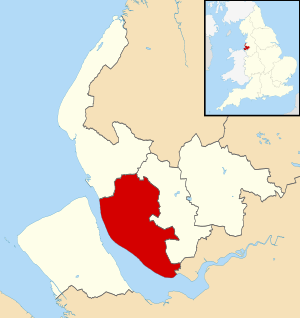
Liverpool shown within Merseyside
|
|||
| Sovereign state | United Kingdom | ||
| Country | England | ||
| Region | North West | ||
| Ceremonial county | Merseyside | ||
| City region | Liverpool | ||
| Founded | 1207 | ||
| City status | 1880 | ||
| Metropolitan borough | 1 April 1974 | ||
| Administrative HQ | Cunard Building | ||
| Districts of the city |
List
Aigburth
Allerton Anfield Belle Vale Broadgreen Canning Childwall Chinatown City Centre Clubmoor Croxteth Dingle Dovecot Edge Hill Everton Fairfield Fazakerley Garston Gateacre Gillmoss Grassendale Hunt's Cross Kensington Kirkdale Knotty Ash Mossley Hill Netherley Norris Green Oglet Old Swan Orrell Park Sefton Park St Michael's Hamlet Speke Stoneycroft Toxteth Tuebrook Vauxhall Walton Wavertree West Derby Woolton |
||
| Government | |||
| • Type | Metropolitan borough | ||
| • Body | Liverpool City Council | ||
| Area | |||
| • Total | 52 sq mi (134 km2) | ||
| • Land | 43.2 sq mi (111.8 km2) | ||
| Area rank | 208th | ||
| Population
(2005 est.)
|
|||
| • Total | 498,042 | ||
| • Rank | 10th | ||
| Demonym(s) |
|
||
| Ethnicity (2021) | |||
| • Ethnic groups |
List
|
||
| Religion (2021) | |||
| • Religion |
List
57.3% Christianity
29.4% no religion 5.3% Islam 0.8% Hinduism 0.4% Buddhism 0.4% Judaism 0.1% Sikhism 0.4% other 5.9% not stated |
||
| Time zone | UTC+0 (GMT) | ||
| • Summer (DST) | UTC+1 (BST) | ||
| Postcode area |
L
|
||
| Dialling code | 0151 | ||
| ISO 3166 code | GB-LIV | ||
| GSS code | E08000012 | ||
Liverpool is a famous city and port in Merseyside, England. It is located on the eastern side of the Mersey Estuary, close to the Irish Sea. In 2005 est., about 498,042 people lived there. Liverpool is the fifth largest city in the UK. It is also the main city of the Liverpool City Region, which has over 1.5 million people.
Liverpool started as a borough in 1207. It became important in the late 1600s because of its port. The Port of Liverpool was a big part of the Atlantic slave trade. It also brought in cotton for factories and was a major starting point for people moving to North America. In the 1800s, Liverpool became very important during the Industrial Revolution. It had the first intercity railway and the first modern warehouse system. It became a city in 1880.
After a tough time in the mid-1900s, Liverpool started to improve. This was especially true after it was chosen as the European Capital of Culture in 2008. This event brought in over £800 million to the city in just one year.
Today, Liverpool's economy is diverse. It includes tourism, culture, shipping, healthcare, and creative industries. The city has many art galleries, national museums, and parks. Only London has more. Liverpool is often used for filming because of its amazing buildings. In 2022, it was the fifth most visited UK city by foreign tourists.
The city has produced many famous musicians, like the Beatles. Artists from Liverpool have had more UK No. 1 hit songs than from any other city. It is also home to the Premier League football teams Everton and Liverpool. The world's oldest train station, Liverpool Lime Street, is in the city centre. The city's port was the fourth largest in the UK in 2023.
People from Liverpool are often called "Scousers." This name comes from scouse, a local stew popular with sailors. The local accent is also called "Scouse." Liverpool is known for its diverse culture, with many immigrants from Ireland, Scandinavia, and Wales. It also has large Black and Chinese communities. England's first mosque was built here.
Contents
- What's in a Name? The Meaning of Liverpool
- A Look Back: The History of Liverpool
- Liverpool's Location and Weather
- Who Lives in Liverpool? Demonyms
- People of Liverpool: Demography
- How Liverpool Makes Money: Economy
- Famous Places: Landmarks
- Getting Around: Transport
- Arts and Entertainment: Culture
- Learning and Schools: Education
- Games and Teams: Sport
- News and Entertainment: Media
- Famous People from Liverpool
- What People Say About Liverpool
- Global Connections: International Links
- Special Honors: Freedom of the City
- Images for kids
- See also
What's in a Name? The Meaning of Liverpool
The name "Liverpool" comes from old English words. Lifer meant "thick or muddy water," and pōl meant "a pool or creek." The name was first written around 1190 as Liuerpul. It likely referred to a pool or tidal creek that is now filled in. Some people thought the name might come from "elverpool," because of the many eels in the River Mersey.
The word "Liverpudlian" to describe someone from Liverpool was first used in 1833. While some people think the name Liverpool has Welsh roots, this is not true. The Welsh name for Liverpool is Lerpwl, which came from an older English local name.
A Look Back: The History of Liverpool
How Liverpool Started: Early Days
In the Middle Ages, Liverpool was mostly farmland. It slowly grew into a small town with farmers, fishermen, and traders. It was also a military base for King John of England. The town was planned with its own castle. However, because of diseases and the nearby Roman port of Chester, Liverpool didn't grow much until the late 1600s and early 1700s. It grew a lot in the mid-1700s when it became the main European port involved in the Atlantic slave trade.
King John officially founded Liverpool as a borough in 1207. He probably chose it because it was a good place to send soldiers and supplies for his campaigns in Ireland. King John is also said to have designed the first street plan for Liverpool. The first seven streets were laid out like a double cross. Liverpool Castle was built before 1235 and was taken down in the 1720s. By the mid-1500s, the population was only about 600 people. It had likely dropped due to diseases like the plague.
In the 1600s, trade and population grew slowly. There were battles for the town during the English Civil War. In 1699, Liverpool became a parish. This was the same year its first slave ship, Liverpool Merchant, sailed to Africa. Before this, Chester was the main port in the region. But as the River Dee became too shallow, trade moved to Liverpool on the River Mersey. The first of the Liverpool docks was built in 1715. Over time, a large system of docks grew.
Trade from the West Indies, especially sugar, became more important than trade with Ireland and Europe. As the River Dee continued to silt up, Liverpool grew very quickly. The first commercial wet dock was built in Liverpool in 1715. Huge profits from the slave trade and tobacco helped the town become rich and grow fast. However, some local people, like William Rathbone IV, were leaders in the movement to end slavery.
Liverpool in the 1800s: A Global Powerhouse
The 1800s saw Liverpool become very important globally. New technologies and public services were launched in the city. Its population grew quickly, with many people from different countries and religions moving there.
By the early 1800s, a lot of trade passed through Liverpool. This wealth led to the building of many grand structures. In 1830, Liverpool and Manchester became the first cities to have a train link between them. The population kept growing fast, especially in the 1840s. Hundreds of thousands of Irish people arrived because of the Great Famine. Many stayed in Liverpool, while others moved to the United States or other industrial areas.
Liverpool was a major market for cotton from the United States. This cotton fed the textile industry in Britain. Because cotton was so important to Liverpool's economy, the city was very supportive of the Confederacy during the American Civil War. Liverpool merchants helped bring cotton out of blockaded ports. They also built warships for the Confederacy and supplied them with military equipment.
For some time in the 1800s, Liverpool was richer than London. Liverpool's Custom House brought in the most money for the British government. At least 40% of the world's trade passed through Liverpool during this century.
By 1851, Liverpool was called "the New York of Europe." In the late 1800s and early 1900s, immigrants from all over Europe came to Liverpool. This led to many different religious buildings being built, like the Deutsche Kirche Liverpool and Princes Road Synagogue.
Liverpool in the 1900s: Challenges and Change
The 1900s brought challenges to Liverpool's global importance. Its location as a seaport made it a target in two World wars. Economic problems and changes in shipping methods caused many job losses. However, the city's influence on popular culture grew. By the end of the century, efforts to rebuild and improve the city began.
After World War I, there was social unrest. Many soldiers returned to unemployment and poor living conditions. In June 1919, there were racial riots in Liverpool and other port cities. This was because colonial soldiers and sailors, who had served with the British forces, settled in Liverpool. They competed for jobs and housing with local people.
In the 1920s and 1930s, many new council houses were built across Liverpool. About 15% of the city's population moved from the inner city to these new suburban areas. This was meant to improve their living standards. During the Great Depression in the early 1930s, unemployment in Liverpool reached about 30%. Liverpool also had Britain's first airport outside London, which opened in 1930.
During World War II, Liverpool was very important strategically. The city was heavily bombed by the Germans in the Liverpool Blitz. About 2,500 people died, and almost half the homes were damaged. The important Battle of the Atlantic was planned and won from Liverpool. After the war, there was a lot of rebuilding. Since 1952, Liverpool has been twinned with Cologne, Germany, which also suffered heavy bombing.
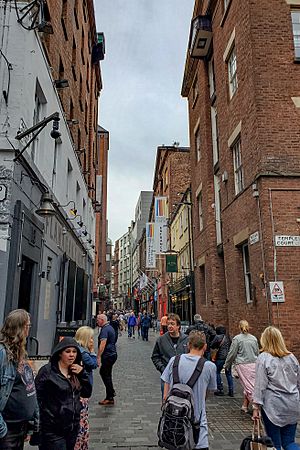
In the 1960s, Liverpool became the center of the "Merseybeat" sound. This sound became famous with the Beatles and other Liverpool rock bands. The Beatles became known worldwide in the early 1960s. They are still the most successful and influential band in popular music history. John Lennon, one of the Beatles, was killed in New York City in 1980. Liverpool Airport was renamed after him in 2002.
Liverpool became a metropolitan borough within the new county of Merseyside in 1974. From the mid-1970s, Liverpool's docks and factories declined. This was due to changes in shipping and industry, causing many job losses. By the early 1980s, unemployment rates were very high. Liverpool became a center of strong opposition to the government in London.
In the late 1900s, Liverpool's economy started to get better. The Albert Dock was redeveloped in the late 1980s. This helped kickstart more regeneration. By the mid-1990s, the city was growing faster than the national average. At the end of the 20th century, Liverpool was focused on regeneration, which continues today.
Liverpool Today: The 21st Century
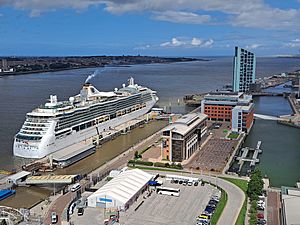
Ongoing regeneration and big international events have helped Liverpool become one of the most visited cities in the UK. City leaders are working on plans to grow the city's population and economy. The national government is also looking at giving the city more local control.
In 2002, Queen Elizabeth II visited Liverpool. She called it "one of the most distinctive and energetic parts of the United Kingdom." She praised the city's "major orchestras, world-class museums and galleries." She also supported Liverpool's bid to become the European Capital of Culture.
Tourism and culture have become very important to Liverpool's economy. This is thanks to the popularity of 1960s rock groups like the Beatles. Also, the city has world-class art galleries, museums, and landmarks.
In 2004, a big development called the Paradise Project started. This £920 million project changed Liverpool's city center a lot. Renamed 'Liverpool One,' it opened in May 2008.
In 2007, Liverpool celebrated its 800th birthday. Liverpool was named a joint European Capital of Culture for 2008. The celebrations included a giant mechanical spider called La Princesse. It was 20 meters tall and weighed 37 tonnes. It roamed the city streets, representing Liverpool's eight key strengths.
Regeneration continued through the 2010s. Important projects included new buildings in the Commercial District and around Lime Street.
In 2014, changes happened to Liverpool's local government. The Liverpool City Council joined with nearby areas to form the Liverpool City Region Combined Authority. This group now oversees and invests in major projects across the Liverpool City Region. They have plans to grow the city's population and economy.
Urban regeneration continues in the 2020s. Liverpool Waters is a huge project to redevelop the city's old northern docklands. Everton's new stadium at Bramley-Moore Dock was the largest private building project in the UK when it started.
Big events and conferences often take place in Liverpool. In 2014, the Prime Minister launched the International Festival for Business in Liverpool. The Labour Party has held its annual conference in Liverpool many times. Liverpool also hosted the Eurovision Song Contest 2023.
Liverpool's Inventions and Innovations
Liverpool has been a center for new ideas and inventions. Railways, steamships, trams, and electric trains were all pioneered here. The world's first railway tunnels were built under Liverpool in 1829 and 1836. From 1950 to 1951, the world's first regular passenger helicopter service ran between Liverpool and Cardiff.
Many "firsts" happened in Liverpool:
- The first School for the Blind.
- The first Mechanics' Institute (for adult education).
- The first High School for Girls.
- The first council house.
- The first Juvenile Court.
- Charities like the RSPCA and NSPCC started from work in the city.
Liverpool also had the first lifeboat station, public bath, and modern sewer system. The first British Nobel Prize was given in 1902 to Ronald Ross, a professor at the Liverpool School of Tropical Medicine. This was the first school of its kind in the world.
In the arts, Liverpool had the first lending library, arts center, and public art conservation center. It is also home to the UK's oldest professional orchestra, the Royal Liverpool Philharmonic Orchestra.
In 1864, Peter Ellis built Oriel Chambers. This was the world's first iron-framed building with a glass "curtain-wall." It was a model for skyscrapers. The UK's first purpose-built department store, Compton House, opened in 1867. It was the largest store in the world at the time.
Between 1862 and 1867, Liverpool held an annual Grand Olympic Festival. These games were the first to be fully amateur and international. The program for the first modern Olympics in Athens in 1896 was almost the same as Liverpool's games.
The first Christmas grotto opened in Lewis's department store in Liverpool in 1879. Sir Alfred Lewis Jones brought bananas to the UK through Liverpool's docks in 1884. The Mersey Railway, opened in 1886, had the world's first tunnel under a tidal river. It also had the world's first deep underground stations.

In 1889, John Alexander Brodie invented the football goal net. He also helped build the UK's first ring road and intercity highway. He oversaw the building of the Queensway Tunnel, which connects Liverpool and Birkenhead. This tunnel was the longest underwater tunnel in the world for 24 years.
In 1897, the Lumière brothers filmed Liverpool. They used what is thought to be the world's first tracking shot, taken from the Liverpool Overhead Railway. This was the world's first elevated electric railway. It was also the first railway to use electric trains and escalators.
Liverpool inventor Frank Hornby created popular toys like Meccano, Hornby Model Railways, and Dinky Toys. The British Interplanetary Society, founded in Liverpool in 1933, is the world's oldest group for promoting spaceflight.
In 1999, Liverpool was the first city outside London to receive blue plaques. These plaques recognize the important contributions of its people.
Liverpool's Location and Weather
Natural Surroundings: Environment
Liverpool is said to have "the most splendid setting of any English city." It is located on Liverpool Bay of the Irish Sea. The city is built on sandstone hills that rise up to about 230 feet (70 meters) high at Everton Hill.
The Mersey Estuary separates Liverpool from the Wirral Peninsula. Liverpool's borders are next to Bootle, Crosby, and Maghull to the north. To the east, it borders Kirkby, Huyton, Prescot, and Halewood.
Weather in Liverpool: Climate
| Weather chart for Liverpool | |||||||||||||||||||||||||||||||||||||||||||||||
|---|---|---|---|---|---|---|---|---|---|---|---|---|---|---|---|---|---|---|---|---|---|---|---|---|---|---|---|---|---|---|---|---|---|---|---|---|---|---|---|---|---|---|---|---|---|---|---|
| J | F | M | A | M | J | J | A | S | O | N | D | ||||||||||||||||||||||||||||||||||||
|
69
8
3
|
57
8
3
|
53
10
4
|
50
13
6
|
53
16
8
|
64
18
11
|
66
20
14
|
72
20
14
|
77
18
11
|
90
14
9
|
82
11
6
|
92
8
3
|
||||||||||||||||||||||||||||||||||||
| temperatures in °C precipitation totals in mm source: Met Office |
|||||||||||||||||||||||||||||||||||||||||||||||
|
Imperial conversion
|
|||||||||||||||||||||||||||||||||||||||||||||||
Liverpool has a mild maritime climate. This means it has mild summers, cool winters, and rain spread throughout the year. Weather records have been kept since 1867. Temperatures have ranged from -17.6°C (0.3°F) in 2010 to 34.5°C (94.1°F) in 1990.
Snow is common in winter, but heavy snow is rare. It usually falls between November and March. Tornadoes are very rare and usually weak.
| Month | Jan | Feb | Mar | Apr | May | Jun | Jul | Aug | Sep | Oct | Nov | Dec | Year |
|---|---|---|---|---|---|---|---|---|---|---|---|---|---|
| Record high °C (°F) | 15.1 (59.2) |
18.9 (66.0) |
21.2 (70.2) |
24.6 (76.3) |
28.2 (82.8) |
30.7 (87.3) |
34.3 (93.7) |
34.5 (94.1) |
30.4 (86.7) |
25.9 (78.6) |
18.7 (65.7) |
15.8 (60.4) |
34.5 (94.1) |
| Mean daily maximum °C (°F) | 7.5 (45.5) |
7.9 (46.2) |
9.9 (49.8) |
12.8 (55.0) |
15.9 (60.6) |
18.4 (65.1) |
20.0 (68.0) |
19.7 (67.5) |
17.7 (63.9) |
14.2 (57.6) |
10.5 (50.9) |
8.0 (46.4) |
13.6 (56.5) |
| Daily mean °C (°F) | 5.2 (41.4) |
5.3 (41.5) |
6.9 (44.4) |
9.2 (48.6) |
12.1 (53.8) |
14.9 (58.8) |
16.7 (62.1) |
16.6 (61.9) |
14.5 (58.1) |
11.4 (52.5) |
8.1 (46.6) |
5.6 (42.1) |
10.5 (50.9) |
| Mean daily minimum °C (°F) | 2.8 (37.0) |
2.7 (36.9) |
3.9 (39.0) |
5.6 (42.1) |
8.3 (46.9) |
11.3 (52.3) |
13.5 (56.3) |
13.5 (56.3) |
11.2 (52.2) |
8.5 (47.3) |
5.7 (42.3) |
3.1 (37.6) |
7.5 (45.5) |
| Record low °C (°F) | −13.1 (8.4) |
−11.3 (11.7) |
−7.2 (19.0) |
−5.6 (21.9) |
−1.7 (28.9) |
3.4 (38.1) |
6.6 (43.9) |
3.1 (37.6) |
1.7 (35.1) |
−2.9 (26.8) |
−7.5 (18.5) |
−17.6 (0.3) |
−17.6 (0.3) |
| Average precipitation mm (inches) | 69.4 (2.73) |
57.1 (2.25) |
53.3 (2.10) |
49.8 (1.96) |
52.5 (2.07) |
64.4 (2.54) |
65.5 (2.58) |
72.1 (2.84) |
76.6 (3.02) |
89.7 (3.53) |
82.2 (3.24) |
91.9 (3.62) |
824.3 (32.45) |
| Average precipitation days (≥ 1.0 mm) | 13.8 | 11.5 | 11.3 | 10.0 | 9.8 | 10.4 | 11.0 | 12.2 | 11.8 | 14.4 | 15.5 | 15.4 | 146.9 |
| Average snowy days | 6 | 5 | 4 | 2 | 0 | 0 | 0 | 0 | 0 | 0 | 1 | 4 | 22 |
| Average relative humidity (%) | 85.1 | 83.5 | 80.7 | 77.9 | 76.6 | 78.9 | 79.0 | 80.1 | 81.9 | 84.6 | 85.1 | 85.6 | 80.8 |
| Mean monthly sunshine hours | 56.0 | 70.3 | 105.1 | 154.2 | 207.0 | 191.5 | 197.0 | 175.2 | 132.7 | 97.3 | 65.8 | 46.8 | 1,499.1 |
| Mean daily daylight hours | 8.2 | 9.9 | 11.9 | 14.1 | 15.9 | 16.9 | 16.4 | 14.7 | 12.7 | 10.5 | 8.6 | 7.6 | 12.3 |
| Average ultraviolet index | 0 | 1 | 2 | 4 | 5 | 6 | 6 | 5 | 4 | 2 | 1 | 0 | 3 |
| Source 1: Met Office | |||||||||||||
| Source 2: National Oceanography Centre WeatherAtlas CEDA Archive | |||||||||||||
People and Places: Human Geography
Liverpool's Neighborhoods: Suburbs and Districts
Some of Liverpool's neighborhoods include:
- Aigburth
- Allerton
- Anfield
- Belle Vale
- Broadgreen
- Canning
- Childwall
- Chinatown
- City Centre
- Clubmoor
- Croxteth
- Dingle
- Dovecot
- Edge Hill
- Everton
- Fairfield
- Fazakerley
- Garston
- Gateacre
- Gillmoss
- Grassendale
- Hunt's Cross
- Kensington
- Kirkdale
- Knotty Ash
- Mossley Hill
- Netherley
- Norris Green
- Oglet
- Old Swan
- Orrell Park
- St Michael's Hamlet
- Speke
- Stoneycroft
- Toxteth
- Tuebrook
- Vauxhall
- Walton
- Wavertree
- West Derby
- Woolton
Green Spaces: Parks and Nature
| UK Core Cities – Population and Density (2021) | |||
|---|---|---|---|
| Core City | Population | Population density | |
| Birmingham | 1,144,900 | 4275.4 | |
| Leeds | 812,000 | 1471.7 | |
| Glasgow | 635,130 | 3637 | |
| Sheffield | 556,500 | 1512.5 | |
| Manchester | 552,000 | 4772.7 | |
| Liverpool | 486,100 | 4346.1 | |
| Bristol | 472,400 | 4308.1 | |
| Cardiff | 362,400 | 2571.3 | |
| Belfast | 345,418 | 2597.8 | |
| Nottingham | 323,700 | 4337.6 | |
| Newcastle | 300,200 | 2646.1 | |
In 2010, Liverpool City Council worked on a "Green Infrastructure Strategy" for the city.
Liverpool is surrounded by a green belt area. This is to stop the city from spreading too much and to protect the countryside. It limits new buildings in certain areas.
Who Lives in Liverpool? Demonyms
What is a Scouser?
Since the mid-1900s, "Scouser" has been the main name for people from Liverpool. It is strongly linked to the unique Scouse accent and way of speaking. The Scouse accent started to become different from the Lancastrian accent in the late 1800s.
The word "Scouser" comes from the traditional dish Scouse. This stew was brought to the area by sailors who traveled through Liverpool's port.
Other Names for Liverpudlians
Before "Scouser" became popular, people used other names for Liverpool residents. These included "Liverpoldon" (1600s) and "Liverpolitan" (1800s). "Liverpudlian" has been used since the 1800s and is still used today.
Experts say that "Scouser" became the most common name by the 1970s. This was partly due to comedians and entertainers who made the Liverpool identity known across the country.
People of Liverpool: Demography
How Many People Live Here? Population
| Historical Population of Liverpool | |||
|---|---|---|---|
| Date | Population | Notes | |
| 1207 | Borough founded by John, King of England. | ||
| 1272 | 840 | ||
| 14th century | 1,000 – 1,200 | Population around 1,000 in 1300. | |
| 16th century | <600 | Population dropped due to plague and slow trade. | |
| 1600 | <2,000 | ||
| 1642 | 2,500 | ||
| 1700 | 5,714 | ||
| 1750 | 20,000 | ||
| 1797 | 77,708 | ||
| 1801 | 77,000 – 85,000 | ||
| 1811 | 94,376 | ||
| 1821 | 118,972 | ||
| 1831 | 165,175 | ||
| 1841 | 286,487 | ||
| 1851 | 375,955 | Many Irish immigrants arrived during the potato famine. | |
| 1861 | 413,000 – 462,749 | ||
| 1871 | 493,405 – 539,248 | ||
| 1880 | Liverpool officially became a city. | ||
| 1881 | 552,508 – 648,616 | ||
| 1891 | 617,032 – 644,243 | ||
| 1901 | 684,958 – 711,030 | ||
| 1907 | 746,144 | ||
| 1911 | 746,421 – 766,044 | ||
| 1921 | 805,046 – 821,000 | ||
| 1931 | 855,688 | ||
| 1937 | 867,000 | Highest recorded population for the city itself. | |
| 1941 | 806,271 | Population began to fall due to people moving to new towns. | |
| 1951 | 765,641 – 768,337 | ||
| 1961 | 683,133 – 737,637 | ||
| 1971 | 595,252 – 607,454 | ||
| 1981 | 492,164 – 503,726 | ||
| 1991 | 448,629 – 480,196 | ||
| 2001 | 439,428 – 439,476 | Population started to increase again. | |
| 2011 | 466,415 | ||
| 2021 | 486,100 | ||
The city of Liverpool is part of a much larger area. In 2021, the area managed by Liverpool City Council had a population of 486,100. This was a 4.2% increase from 2011. By 2022, this number grew to 500,500 people.
Liverpool was the fifth largest of England's "core cities" in 2021. It also had the second highest population density among them. The city's population has been growing steadily since 2001.
Liverpool's population is younger than England's overall. Family life in the city is also changing. More households have couples without children, which is different from the wider North West region. Also, more people aged 16 and over are employed in Liverpool.

The 2021 Census also showed that Liverpool's diverse population is growing. More residents were born outside England than before. Also, more people did not identify with a UK national identity. The number of people identifying as Asian and Black increased. The percentage of people identifying as white decreased.
It is believed that up to 75% of Liverpool's population has some Irish ancestry.
Liverpool's population grew in the 21st century. This reversed a trend from the 1930s to 2001, when the city's population almost halved. This was because thousands of people were moved to new towns outside the city.
Liverpool's Wider Area: Urban and Metropolitan
Liverpool is usually grouped with the wider Merseyside area to define its metropolitan size. Sometimes, this area includes towns in nearby Lancashire and Cheshire.
The Office for National Statistics (ONS) uses "International Territorial Levels" (ITLs) to divide the UK for economic data. Liverpool is part of these regions:
- ITL 1 region: North West England (7,417,300 people in 2021).
- ITL 2 region: Merseyside (1,551,500 people in 2021). This includes Liverpool and other boroughs like Halton, Knowsley, St. Helens, Sefton, and Wirral.
- ITL 3 region: Liverpool itself (486,100 people in 2021).
The ONS also uses "built-up areas" (BUAs) based on how much land is developed. In 2021, the Liverpool Built-up Area was the third largest in England (excluding London), with about 506,565 residents. This means Liverpool's built-up area is larger than many other major English cities.
The Liverpool City Region was the 4th largest "combined authority" area in England in 2021. It has about 1.6 million people. This group works together on important regional matters.
Different Backgrounds: Ethnicity
In recent years, Liverpool's population has become more multicultural. In 2021, 77% of residents identified as White English, Welsh, Scottish, Northern Irish, or British. The other 23% were from non-White English/British backgrounds. The number of 'Other White residents' increased by almost 12,000 people. There were also notable increases in 'Other Asian', 'Arab', and 'Other Mixed/Multiple' groups.
9 out of 10 Liverpool residents said English was their main language. The most common non-English languages were Arabic (5,743 speakers) and Polish (4,809 speakers).
| Ethnic Breakdown in Liverpool – (2021 Census) | |||
|---|---|---|---|
| Ethnic group | Population | Percentage | |
| White: English, Welsh, Scottish, Northern Irish or British | 375,785 | 77.3 | |
| White: Other White | 24,162 | 5 | |
| Black, Black British, Black Welsh, Caribbean or African: African | 12,709 | 2.6 | |
| Asian, Asian British or Asian Welsh: Chinese | 8,841 | 1.8 | |
| Other ethnic group: Arab | 8,312 | 1.7 | |
| Other ethnic group: Any other ethnic group | 7,722 | 1.6 | |
| Asian, Asian British or Asian Welsh: Other Asian | 7,085 | 1.5 | |
| White: Irish | 6,826 | 1.4 | |
| Asian, Asian British or Asian Welsh: Indian | 6,251 | 1.3 | |
| Mixed or multiple ethnic groups: Other mixed or multiple ethnic groups | 4,934 | 1 | |
| Mixed or multiple ethnic groups: White and Black African | 4,157 | 0.9 | |
| Mixed or multiple ethnic groups: White and Black Caribbean | 4,127 | 0.8 | |
| Asian, Asian British or Asian Welsh: Pakistani | 3,673 | 0.8 | |
| Mixed or multiple ethnic groups: White and Asian | 3,662 | 0.8 | |
| Black, Black British, Black Welsh, Caribbean or African: Other Black | 2,762 | 0.6 | |
| Asian, Asian British or Asian Welsh: Bangladeshi | 1,917 | 0.4 | |
| Black, Black British, Black Welsh, Caribbean or African: Caribbean | 1,493 | 0.3 | |
| White: Roma | 1,169 | 0.2 | |
| White: Gypsy or Irish Traveller | 501 | 0.1 | |
Liverpool has Britain's oldest Black community, dating back to the 1730s. Some Liverpudlians can trace their Black family history back ten generations. Early Black settlers included sailors and freed slaves. Since the 1900s, Liverpool has also had large African-Caribbean, Ghanaian, and Somali communities.

The city also has the oldest Chinese community in Europe. The first Chinese residents arrived as sailors in the 1800s. The traditional Chinese gateway in Liverpool's Chinatown is the largest outside China. Liverpool also has a long-standing Filipino community.
The city is also known for its large Irish and Welsh populations. In 1813, 10% of Liverpool's population was Welsh. During the Great Irish Famine in the mid-1800s, up to two million Irish people traveled to Liverpool. Many then left for the United States. By 1851, over 20% of Liverpool's population was Irish.
Other groups living in Liverpool today include Indian, Latin American, Malaysian, and Yemeni communities.
Faiths and Beliefs: Religion
| Religion of Liverpool residents, 2021 | ||||
|---|---|---|---|---|
| Christian | 57.3% | |||
| No religion | 29.4% | |||
| Religion not stated | 5.9% | |||
| Muslim | 5.3% | |||
| Hindu | 0.8% | |||
| Buddhist | 0.4% | |||
| Any other religion | 0.4% | |||
| Jewish | 0.4% | |||
| Sikh | 0.1% | |||
| Source: 2021 census | ||||
Many migrants and sailors passing through Liverpool led to a mix of religions. This is still seen today in the city's many religious buildings, including two Christian cathedrals.
Liverpool is known as England's "most Catholic city." This is mainly because many Irish people moved to the city over time.
The main church of Liverpool is the Anglican Our Lady and St Nicholas. It is known as "the sailors church" and has been near the waterfront since 1257.
Liverpool's wealth as a port city allowed for the building of two huge cathedrals in the 1900s. The Anglican Cathedral was built between 1904 and 1978. It is the largest cathedral in Britain and the fifth largest in the world. The Roman Catholic Metropolitan Cathedral was built between 1962 and 1967. It has the largest stained glass panel in the world. The street between the two cathedrals is called Hope Street.
Liverpool has several synagogues. The Princes Road Synagogue is especially beautiful. Liverpool also has a thriving Jewish community of about 5,000 people.
The city had the earliest Mosque in England, founded in 1887. The largest mosque, Al-Rahma mosque, was also the third purpose-built mosque in the UK.
How Liverpool Makes Money: Economy
City and Region's Economy
Liverpool is a key part of North West England's economy, which is the third largest regional economy in the UK. The city also contributes a lot to the Liverpool City Region's economy, which is worth over £40 billion each year.
In 2021, 51.1% of Liverpool's population aged 16 and over were employed. The most popular industries for jobs were healthcare, retail, education, and public administration.
In 2023, Liverpool City Council made a plan for economic growth over the next 20 years. They will focus on tourism, culture, life sciences, digital industries, and advanced car manufacturing.
Liverpool was one of the top 5 most visited UK cities by foreign tourists in 2022. The city's tourist industry is worth £3.5 billion annually. Tourism related to the Beatles alone brings in about £100 million each year. Liverpool One is a major shopping area, making Liverpool a top shopping destination. The Liverpool Cruise Terminal allows tourists to arrive right in the city center.
Liverpool is home to the Knowledge Quarter. This area has many important institutions in science, health, technology, and education. The UK government sees Liverpool as a leader in making medicines and in bioprocessing. In 2023, the city was chosen for England's second "Investment Zone." This means millions of pounds will be invested in science areas like the Knowledge Quarter.
Car manufacturing also happens in the city at the Jaguar Land Rover Halewood plant. The Range Rover Evoque is put together there. In 2023, Jaguar Land Rover announced that the Halewood plant would start focusing on making electric cars.
Historically, Liverpool's economy was based on its port and factories. Today, the Port of Liverpool is the UK's fourth busiest port for cargo. It handles over 30 million tonnes of freight each year. It is also the main port in the country for trade across the Atlantic Ocean. In 2023, Liverpool was chosen as a "Freeport" to encourage more international trade.
The Liverpool2 container terminal, finished in 2022, has greatly increased the amount of cargo Liverpool can handle. It can now handle the world's biggest container ships.
Liverpool is also home to many UK headquarters or major offices for shipping and freight companies. The city's rich architecture has made it the second most filmed city in the UK after London. It often looks like other cities like Chicago, London, or New York in films.
City Region Economy and Devolution
The Liverpool City Region GDP in 2021 was £40.479 billion. The 6 contributing boroughs to this GDP were as follows: Liverpool
(£15.911 billion) (39.3%) Wirral
(£6.632 billion) ({{{value2}}}%) Sefton
(£5.431 billion) ({{{value3}}}%) Knowsley
(£4.557 billion) ({{{value4}}}%) Halton
(£4.498 billion) ({{{value5}}}%) St Helens
(£3.448 billion) ({{{value6}}}%)
The British Government watches the economies of UK cities and their regions. They want to see if they can give more power and money from central government to local authorities. This helps them understand the city's "functional economic area."
As of 2023, there are 10 city regions in England with Combined Authorities. Here's how Liverpool's economy compares to others:
| Combined authority area | Core city (if applicable) | GVA (2021) (£ billions) |
GDP (2021) (£ billions) |
GDP per head (2021) (£) |
|---|---|---|---|---|
| Cambridgeshire and Peterborough | 28.648 | 31.698 | 35,348 | |
| Greater Manchester | Manchester | 78.744 | 87.703 | 30,576 |
| Liverpool City Region | Liverpool | 35.345 | 40.479 | 26,086 |
| North East | 22.516 | 26.255 | 23,038 | |
| North of Tyne | Newcastle upon Tyne | 19.725 | 22.444 | 27,075 |
| South Yorkshire | Sheffield | 28.971 | 33.528 | 24,399 |
| Tees Valley | 14.241 | 16.346 | 24,103 | |
| West Midlands | Birmingham | 70.961 | 79.076 | 27,117 |
| West of England | Bristol | 34.110 | 37.571 | 39,371 |
| West Yorkshire | Leeds | 60.137 | 67.607 | 28,769 |
Famous Places: Landmarks
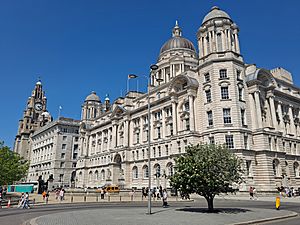
Liverpool's long history of trade has given it many different architectural styles. Most buildings date from the late 1700s onwards, when the city became a major power. There are over 2,500 listed buildings in Liverpool. English Heritage has called Liverpool England's finest Victorian city.
In 2004, some areas of Liverpool were made a UNESCO World Heritage Site. This was because of the city's role in developing international trade and dock technology. However, this status was removed in 2021. This was because new developments, like the Bramley-Moore Dock Stadium, had changed the area too much.
Along the Water: Waterfront and Docks
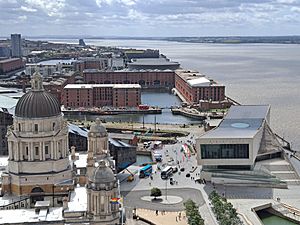
As a major British port, Liverpool's docks have always been key to its growth. The city had the world's first enclosed wet dock in 1715. The most famous dock is the Royal Albert Dock, built in 1846. It has the largest collection of Grade I listed buildings in Britain. Today, the Royal Albert Dock has restaurants, shops, hotels, and museums like the Merseyside Maritime Museum and The Beatles Story.
One of Liverpool's most famous spots is the Pier Head. It has three famous buildings: the Royal Liver Building, the Cunard Building, and the Port of Liverpool Building. These are known as the Three Graces. They show how wealthy the city was in the late 1800s and early 1900s. They are a symbol of Liverpool's maritime history.
In the 21st century, many parts of Liverpool's waterfront have been redeveloped. New buildings include the Museum of Liverpool and the Liverpool Arena. The The Wheel of Liverpool opened in 2010.
City Center: Commercial and Cultural Areas
Liverpool's history as a major trading port meant many grand buildings were built for businesses. This wealth also led to grand public buildings.
The main commercial area is around Castle Street, Dale Street, and Old Hall Street. Many of these streets still follow their medieval layout. The oldest building here is the Liverpool Town Hall, built in 1754. It is known as one of Britain's most decorated public buildings.
The area around William Brown Street is called the 'Cultural Quarter'. It has many public buildings like the William Brown Library and Walker Art Gallery. This area is known for its neo-classical architecture. The most famous building is St George's Hall. It is considered one of the best neo-classical buildings in Europe. William Brown Street also has many statues and monuments.
Other Important Buildings and Places
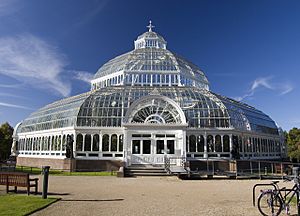
While most of Liverpool's buildings are from the mid-1700s onwards, some are older. One of the oldest is Speke Hall, a Tudor manor house finished in 1598. It is one of the few remaining timber-framed Tudor houses in northern England. Other old manor houses include Croxteth Hall and Woolton Hall.
The oldest building in the city center is the Bluecoat Chambers, built between 1717 and 1718. It was originally a school and is now an arts center.
Liverpool is famous for its two cathedrals. The Anglican Cathedral is the largest in Britain and the fifth largest in the world. It was built between 1904 and 1978. The Roman Catholic Metropolitan Cathedral was built between 1962 and 1967. It is known for its modern design.
In the 21st century, many parts of Liverpool's city center have been redeveloped. The largest project was Liverpool One, which involved almost £1 billion. It created new shops, offices, homes, and leisure spaces. New skyscrapers have also been built, like West Tower, which is Liverpool's tallest building at 140 meters.
Other notable buildings include the former terminal building of Speke Airport and the University of Liverpool's Victoria Building.
Green Spaces: Parks and Gardens
Merseyside's Victorian Parks are considered "the most important in the country." Liverpool has ten listed parks and cemeteries. This includes two Grade I and five Grade II* listed parks, more than any other English city except London.
Getting Around: Transport
Liverpool has a large transport system connecting it to its local area, the UK, Europe, and the world. You can travel by road, rail, air, and sea. Local buses, trains, and ferries are managed by Merseytravel. The city's port and international airport provide global links for people and goods.
Traveling Far: National and International Connections
Roads and Motorways
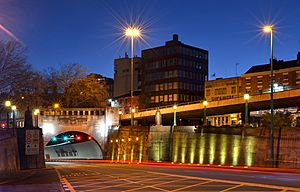
Liverpool is at the center of a large urban area. The city's neighborhoods blend into nearby towns. The wider region has many motorways and main roads. The closest motorways are the M58 to the north, and the M62 and M57 to the east.
The M58 motorway goes for 12 miles and connects to nearby counties. The M62 crosses northern UK, linking Liverpool to Hull and cities like Manchester and Leeds. It also connects to the M6 and M1 motorways, reaching cities like London.
The M57 is a 10-mile ring road for the city. It links the M62 and M58 motorways.
To the south, Liverpool connects to Widnes and Warrington via the A562 and A5300. It also connects across the River Mersey to Runcorn via two bridges. The M56 motorway then leads to other counties and Manchester Airport.
The Kingsway and Queensway Tunnels connect Liverpool to the Wirral Peninsula across the Mersey.
Train Travel
Liverpool has two train networks. The local network, Merseyrail, connects the city throughout the Liverpool city region. The national network, managed by Network Rail, connects Liverpool to major UK cities. The main station is Lime Street station. It has direct services to London (in about 2 hours 8 minutes), Birmingham, Glasgow, Manchester, and many other places. Opened in 1836, Lime Street is the world's oldest main train station still in use. Liverpool South Parkway in the south of the city connects to Liverpool Airport.
Port and Ferries
The Port of Liverpool connects people and goods worldwide. Passenger ferries go from Liverpool across the Irish Sea to Belfast and the Isle of Man.
The Liverpool Cruise Terminal handles over 200,000 passengers each year. It is located near the Pier Head. Many different cruise lines use this terminal. It serves ports in Australia, France, North America, and other places.
As of 2022, the Port of Liverpool was the fourth busiest port in the UK for cargo. It handles 33 million tonnes of freight. It is the main port for transatlantic trade. The Liverpool2 container terminal can handle the world's biggest container ships.
The Leeds and Liverpool Canal also runs into Liverpool city center.
Airport Connections
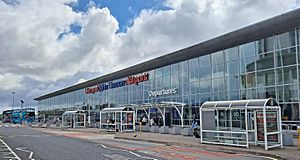
Liverpool John Lennon Airport, in the south of the city, has direct flights across the UK and Europe. It offers services to over 60 airports worldwide. The airport is mainly used by low-cost airlines.
Getting Around Locally: City Travel
Local Trains: Merseyrail
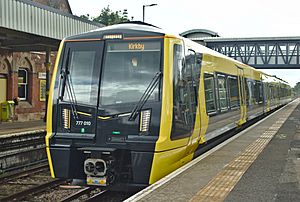
Liverpool's local train network, Merseyrail, is one of the busiest in the country. It has about 30 million passenger journeys each year. The system has 69 stations across Liverpool's area.
The network has three lines: the Northern Line, the Wirral Line, and the City Line. Most of the network is electric. Within Liverpool city centre, four stations and over 6.5 miles (10.5 km) of tunnels are underground. Hamilton Square and Liverpool James Street are the oldest deep underground stations in the world. In 2023, battery-powered passenger trains started running on Merseyrail tracks.
Buses in Liverpool
Local bus services are managed by Merseytravel. They are run by companies like Arriva and Stagecoach. The two main bus stations are Queen Square bus station (for services north and east) and Liverpool One bus station (for services south and east). There are also night bus services on Saturdays. National Express services go to and from destinations across the UK.
Mersey Ferry
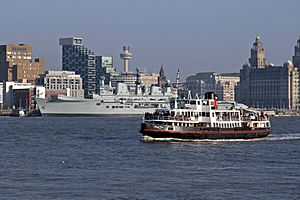
The cross-river ferry service, the Mersey Ferry, is managed by Merseytravel. It runs between the Pier Head in Liverpool city center and Woodside and Seacombe on the Wirral Peninsula. The ferry is also a popular tourist attraction, offering historical tours of the River Mersey.
Cycling and Scooters
Liverpool has a scooter-sharing system and electric bicycle scheme. You can rent scooters and bikes to get around the city. National Cycle Route 56, National Cycle Route 62, and National Cycle Route 810 run through Liverpool.
Arts and Entertainment: Culture
Liverpool is an important cultural center in the UK. It is known for its music, performing arts, museums, and art galleries. In 2008, the city was the European Capital of Culture. Many cultural events took place then, including Go Superlambananas! and La Princesse. Liverpool has also hosted Europe's largest music and poetry event, the Welsh national Eisteddfod, three times.
Music City: Liverpool's Sound
Liverpool is famous worldwide for music. Guinness World Records calls it the "World Capital City of Pop." Musicians from Liverpool have had 58 No. 1 hit songs, more than any other city. Both the most successful male band (The Beatles) and girl group (Spice Girls) in music history have members from Liverpool.
Liverpool is most famous as the birthplace of the Beatles. In the 1960s, it was the center of the Beat Music movement. Many famous musicians from that time came from the city, like Cilla Black and Gerry and the Pacemakers. Other famous musicians from Liverpool include Echo & the Bunnymen and Frankie Goes to Hollywood.

The city is also home to the oldest professional symphony orchestra in the UK, the Royal Liverpool Philharmonic Orchestra.
Popular festivals in the city include Africa Oyé and Brazilica. These are the UK's largest free African and Brazilian music festivals. The Creamfields dance music festival also started from the Liverpool-based Cream club. The Liverpool Arena is the largest music venue. It opened in 2008 and has hosted many world-famous acts.
In 2022, Liverpool was chosen to host the Eurovision Song Contest 2023. This was on behalf of Ukraine, which could not host due to security concerns. The contest was held at Liverpool Arena in May 2023. This was the first time Liverpool hosted the event.
Art and Galleries: Visual Arts

Liverpool has more art galleries and national museums than any other UK city except London. National Museums Liverpool is the only English national collection entirely outside London. The Tate Liverpool gallery has a modern art collection. The Walker Art Gallery has one of the best collections of Pre-Raphaelite art in the world.
The Liverpool Biennial is an arts festival that runs from mid-September to late November.
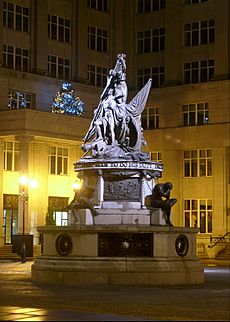
Stories and Poems: Literature
Many famous authors have visited Liverpool, including Daniel Defoe and Charles Dickens. Herman Melville's novel Redburn is partly set in Liverpool. Nathaniel Hawthorne was the US consul in Liverpool from 1853 to 1856.
Constantine P. Cavafy, a famous Greek poet, spent part of his childhood in Liverpool in the 1870s.
Her Benny, a novel about Liverpool street children in the 1870s, was a best-seller. Novelist Beryl Bainbridge (1932–2010) was born in Liverpool. She was known for her psychological fiction.
In the late 1960s, Liverpool became known for the Liverpool poets, including Roger McGough and Adrian Henri. Their poetry collection, The Mersey Sound, has sold very well.

Liverpool has also produced several famous horror writers, like Ramsey Campbell and Clive Barker.
On Stage: Performing Arts
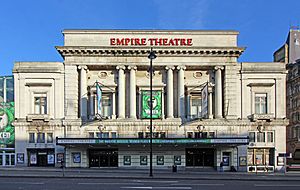
Liverpool has a long history of performing arts. It hosts several annual theater festivals, like the Liverpool Shakespeare Festival. The city has many theaters, including the Empire, Everyman, and Playhouse.
Many famous actors and actresses are from Liverpool. These include Jodie Comer, Stephen Graham, and Kim Cattrall. Some actors from other countries also have strong ties to the city, like Mike Myers and Halle Berry.
Fun After Dark: Nightlife
Liverpool has a lively and varied nightlife. Most of the city's late-night restaurants, bars, clubs, and music venues are in different areas.
In 2023, spending in Liverpool city center bars and restaurants was higher than in other major UK cities, including London. The busiest nights in the city center are Friday and Saturday. Over 1.5 million people pass through the city center on Friday nights, and almost 2 million on Saturday nights.
Liverpool's nightlife is focused in areas like Ropewalks, which includes Concert Square. Other popular areas are Hardman Street, the Cavern Quarter, and the Baltic Triangle.
Learning and Schools: Education

In Liverpool, primary and secondary education is available through state schools. These include secular schools and those linked to the Church of England, Jewish, and Roman Catholic faiths. Islamic education is available at primary level.
One of Liverpool's important early schools was The Liverpool Blue Coat School, founded in 1708. It is now a state grammar school. Other notable schools include Liverpool College.
Liverpool has three universities: the University of Liverpool, Liverpool John Moores University, and Liverpool Hope University. Edge Hill University started in Liverpool but is now in Ormskirk. Liverpool is also home to the Liverpool Institute for Performing Arts (LIPA).
The University of Liverpool was founded in 1881. It was the first university to offer degrees in subjects like biochemistry and architecture.
Liverpool Hope University gained university status in 2005. It is the only ecumenical (Christian unity) university in Europe.
The Liverpool School of Tropical Medicine was founded to solve problems from trade. It is now a post-graduate school.
Liverpool John Moores University became a university in 1992. It is named after Sir John Moores, a major supporter. It started as the Liverpool Mechanics' institute in 1823, making it England's third-oldest university by that measure.
The city has one further education college, City of Liverpool College. There are also two Jewish schools in Liverpool.
Games and Teams: Sport
Football Fever: Soccer in Liverpool
Liverpool is one of England's most successful football cities. It is home to two top Premier League teams: Everton F.C. and Liverpool F.C.. Everton was founded in 1878 and plays at Goodison Park. Liverpool F.C. was founded in 1892 and plays at Anfield. Together, they have won many English and European titles.
The two clubs play against each other in the Merseyside derby. This match is known for its strong rivalry. Unlike many other derbies, it's common for families in Liverpool to support both clubs. Liverpool F.C. has won the most European Cup titles (six) of any English or British club.
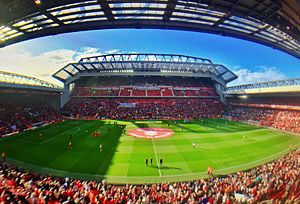
Liverpool has played at Anfield since 1892. The stadium has been completely rebuilt since the 1970s. The Spion Kop stand is very famous for its passionate fans. Anfield can hold 54,000 spectators.
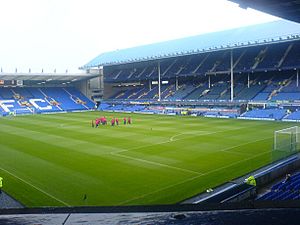
After leaving Anfield in 1892, Everton moved to Goodison Park. It opened in 1892 and was one of the host venues for the 1966 FIFA World Cup. It can hold almost 40,000 spectators.
Everton is building a new stadium at Bramley-Moore Dock on the River Mersey waterfront. It will have a capacity of 52,888 and could be expanded. It will also be a host venue for the UEFA Euro 2028.
Boxing in the City
Boxing is very popular in Liverpool. The city has a proud history in the sport. It has about 22 amateur boxing clubs that have produced many successful boxers. Liverpool is the most represented city on the GB Boxing team. Many Liverpool amateur fighters have won medals at the Olympic Games. Boxing events are usually held at the Liverpool Arena and Liverpool Olympia.
Horse Racing at Aintree
Aintree Racecourse, located nearby, is home to the world's most famous steeplechase, the Randox Grand National. This race happens every April. It attracts horse owners and jockeys from around the world to compete on the challenging 4-mile (6.4 km) course with 30 fences.
Golfing Greens
The Royal Liverpool Golf Club, in nearby Hoylake, has hosted The Open Championship many times, most recently in 2023.
Other Sports
Wavertree Sports Park is home to the Liverpool Harriers athletics club. This club has produced athletes like Katarina Johnson-Thompson, who won a gold medal at the 2019 World Championships.
In August 2012, Liverpool gymnast Beth Tweddle won an Olympic bronze medal. She became the most decorated British gymnast in history.
Liverpool has also produced several swimmers who have competed at the Olympic Games. Steve Parry won a bronze medal in 2004.
The city is a hub for the Liverpool and District Cricket Competition. Liverpool and Sefton Park are founding members.
Since 2014, Liverpool Cricket Club has hosted the annual Liverpool International Tennis Tournament. Tennis stars like Novak Djokovic have played there.

Professional basketball came to Liverpool in 2007 with the Everton Tigers, later called Mersey Tigers. They played in Britain's top league.
Liverpool is one of three cities that still host the traditional sport of British baseball. The Liverpool Trojans are the oldest baseball club in the UK.
The 2014 Tour of Britain cycle race started in Liverpool.
A 2016 study found that Liverpool had the highest number of leisure and sports centers per person among top UK urban areas.
News and Entertainment: Media
The city has one daily newspaper, the Echo. The independent The Post also covers Liverpool. Nerve magazine publishes articles about cultural events.
Liverpool TV is a local television station for the Liverpool City Region. It broadcasts from studios in Liverpool.
The ITV region covering Liverpool is ITV Granada. The BBC also has a newsroom in Liverpool.
ITV's daily show This Morning was broadcast from the Royal Albert Dock until 1996.
Liverpool is home to the TV production company Lime Pictures. They produced the soap operas Brookside and Hollyoaks.
Radio stations include BBC Radio Merseyside, Hits Radio Liverpool, and Greatest Hits Radio. Hits Radio and Greatest Hits Radio are located in St Johns Beacon, a tall tower in the city.
Liverpool has also been featured in many films. It has "doubled" for cities like London, Paris, New York, and Moscow.
Famous People from Liverpool
What People Say About Liverpool
- "Liverpool is one of the wonders of Britain... In a word, there is no town in England, London excepted, that can equal [it] for the fineness of the streets, and the beauty of the buildings." – Daniel Defoe, 1721–1726
- "I have heard of the greatness of Liverpool, but the reality far surpasses my expectation." – Prince Albert, 1846
- "Liverpool... has become a wonder of the world. It is the New York of Europe, a world city rather than merely British provincial." – Illustrated London News, 1886
- "Liverpool is the 'pool of life.' The 'liver,' according to an old view, is the seat of life, that which makes to live." – C. G. Jung, 1928
- "If Liverpool can get into top gear again, there is no limit to the city's potential. The scale and resilience of the buildings and people is amazing – it is a world city, far more so than London and Manchester." – Ian Nairn, 1967
Global Connections: International Links
Twin Cities
Liverpool is twinned with:
- Surabaya, Indonesia (2017)
- Birmingham, Alabama, United States (2015)
- Cologne, Germany (1952)
- Dublin, Ireland (1997)
- Johor Bahru, Malaysia
- Medan, Indonesia
- Odesa, Odesa Oblast, Ukraine
- Penang, Malaysia
- Rio de Janeiro, Brazil (2003)
- Shanghai, China (1999)
Friendship Links
Liverpool has friendship links with these cities:
- Givenchy-lès-la-Bassée, France
- Halifax, Canada
- Havana, Cuba
- La Plata, Argentina
- Memphis, US
- Minamitane, Japan
- Naples, Italy
- New Orleans, US
- Ponsacco, Italy
- Râmnicu Vâlcea, Romania
- Valparaíso, Chile
- Guadalajara, Mexico
Consulates in Liverpool
The first overseas consulate of the United States opened in Liverpool in 1790. Today, many countries have consulates in the city, including Chile, Denmark, France, Germany, and Norway.
Special Honors: Freedom of the City
The "Freedom of the City" is a special honor given to people and military units in Liverpool.
Individuals Honored
- List of Freemen of the City of Liverpool.
Military Units Honored
- Duke of Lancaster's Regiment: 14 September 2008.
- War Widows Association (Merseyside Branch): 1 December 2014.
- 208 (3rd West Lancashire) Battery 103rd (Lancashire Artillery Volunteers) Regiment Royal Artillery: 14 October 2017.
- 8th Engineer Brigade, RE: 11 December 2020.
Organizations and Groups Honored
- The Pain Relief Foundation: 3 March 2010.
- The Whitechapel Centre: 5 October 2016.
- The Parachute Regiment Association (Liverpool Branch): 24 October 2021.
- The Royal Signals Association (Liverpool Branch): 26 November 2021.
Images for kids
-
Lewis's department store. The first Christmas grotto was created here in 1879.
-
Liverpool was the first city outside London to get an official Blue plaque.
-
Constantine P. Cavafy, a famous poet, spent part of his life in Liverpool.
-
Clive Barker, a Liverpool-born writer of horror fiction.
See also
 In Spanish: Liverpool para niños
In Spanish: Liverpool para niños







